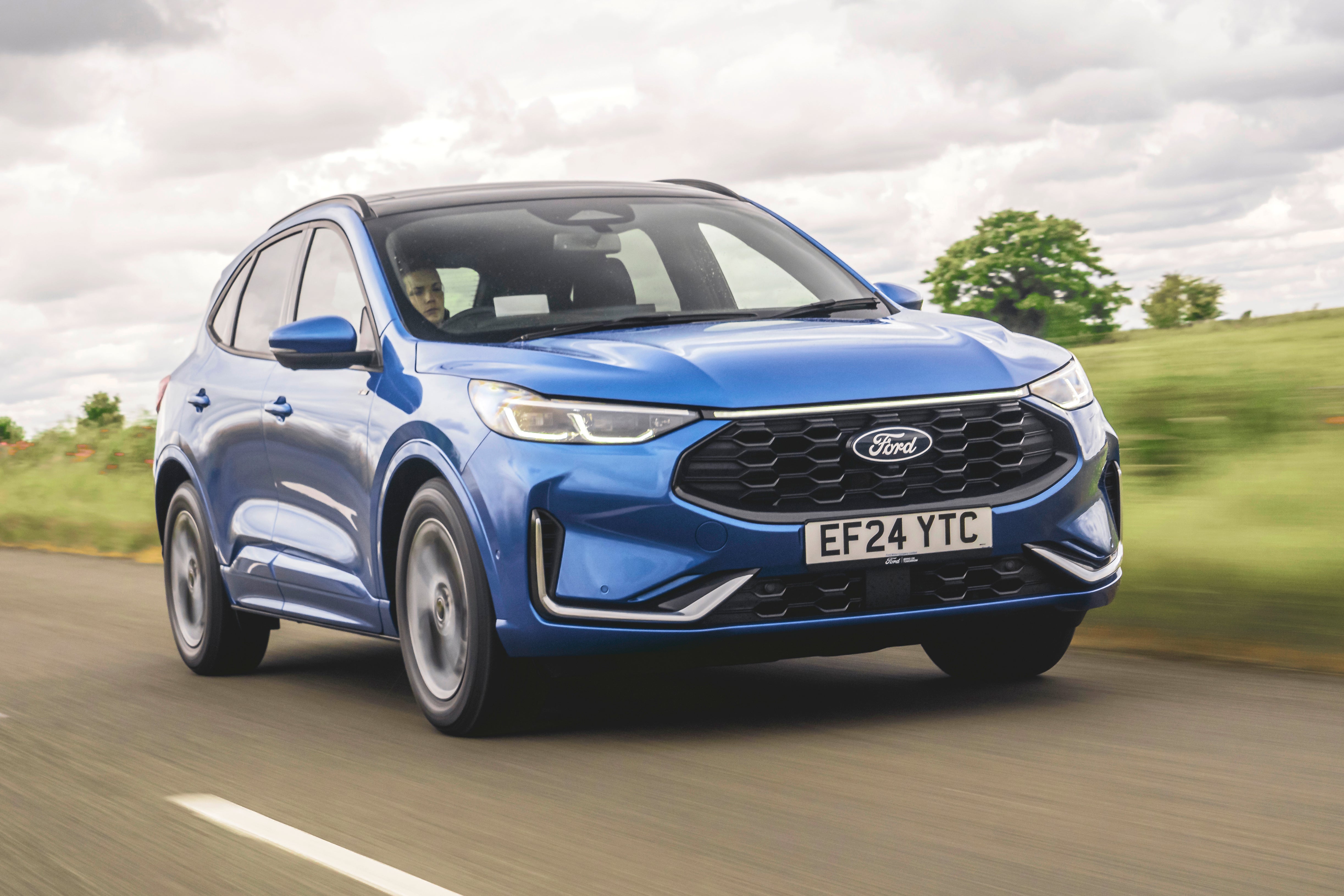Ford Kuga Review 2024
Written by Andrew Brady
Quick overview
Pros
- Improved tech from 2024
- Lots of standard equipment
- Choice of petrol, hybrid and plug-in hybrid engines
Cons
- Not available as a seven-seater
- Petrol engine feels underpowered
- Interior isn't as posh as rivals
Overall verdict on the Ford Kuga
"Recent updates to the Ford Kuga mean it's a stronger choice than ever before, thanks to up-to-date technology and a more attractive exterior design. Its wide range of engines - including petrol, hybrid and plug-in hybrid power - mean there's a Kuga to suit almost every buyer, too. It's a shame the interior doesn't feel quite as plush as rivals, while you can't buy the Kuga with seven seats - but most buyers won't be too concerned about that."
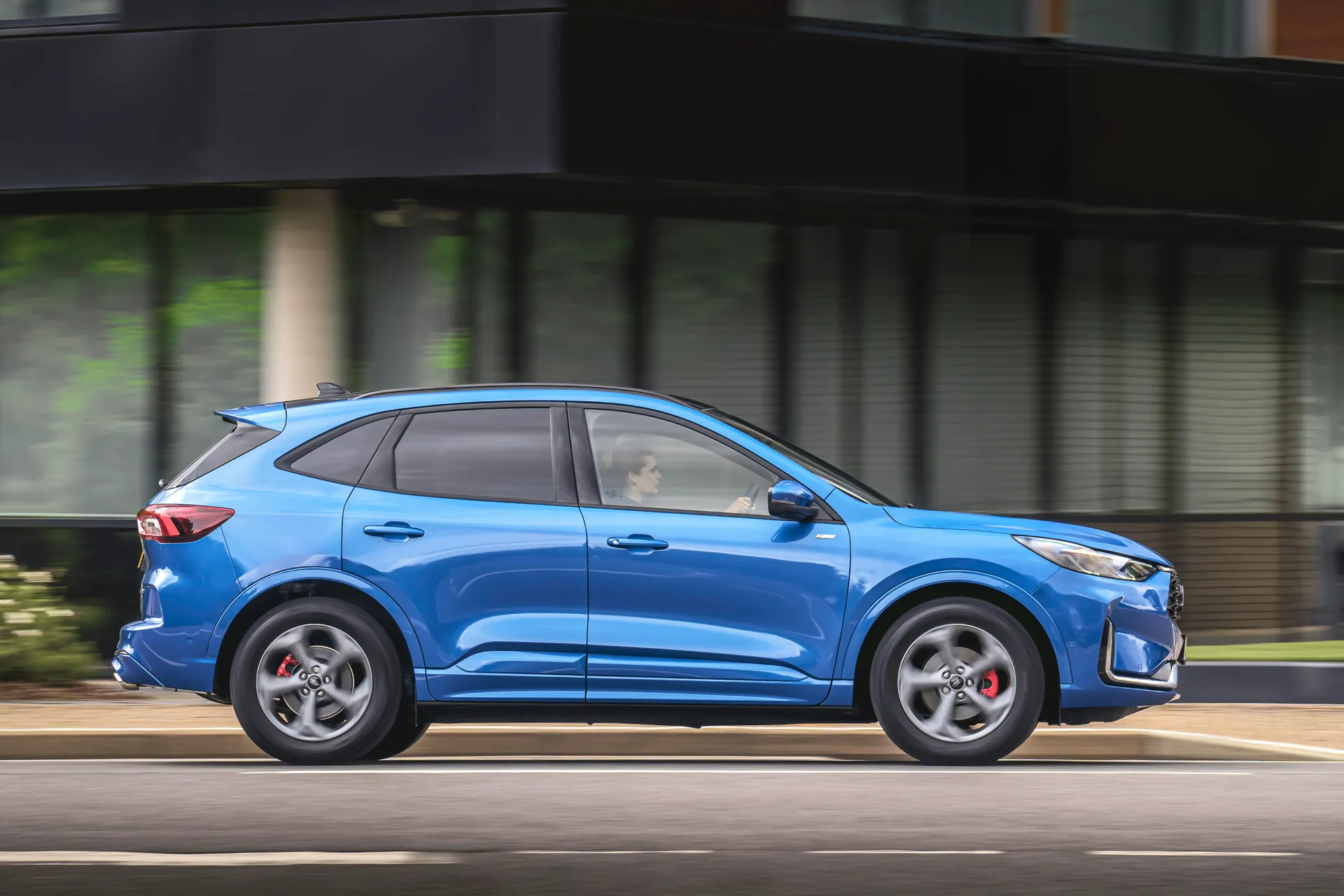
The 2024 Ford Kuga is the Blue Oval's take on the family SUV. This third-generation car is a big step up from the car it replaced in 2020, with this latest version more than up to the job of taking on established rivals like the Toyota RAV4, Honda CR-V and Mazda CX-5. Let's take a closer look in our 2024 Ford Kuga review.
When the latest Ford Kuga was first launched, there was a pretty broad choice of engines on offer, including a couple of diesel engines. Ford later streamlined the engine range of the Kuga, removing the diesel-powered engines and some of the petrols. This leaves a petrol, a self-charging hybrid and a plug-in hybrid version to choose from. Don't expect to see an electric Ford Kuga, with Ford offering the EV-only Mustang Mach-e, Ford Capri and Ford Explorer for those looking for an electric SUV.
While Ford has a reputation for making cars that are great to drive, the previous Kuga was a bit sloppy. Fortunately, the latest model is back on form, with handling sharp enough to take on the Mazda CX-5. Due to the weight of its batteries, the PHEV model does lose some of this agility, but it's still sharp by PHEV standards, and the Ford Kuga is an easy car to drive around town, helped by its high seating position and parking camera, which is now standard across the range.
A downside of the sharp handling is the slightly firm ride quality, especially on models with bigger alloy wheels fitted, or the Kuga ST-Line trim with its sports suspension. It’s not uncomfortably harsh, but it’s not as compliant as the soft Citroen C5 Aircross.
No matter which Ford Kuga model you buy, it will be pretty comprehensively equipped as standard. The kit list on even the most affordable Titanium trim feels far from meagre, with 17-inch alloy wheels, Ford's impressive SYNC 4 navigation system and a digital instrument cluster as standard, as well as cruise control and keyless entry.
The Ford Kuga Active adds nice-to-have features such as a 360-degree camera, B&O premium sound system and a heap of driver-assistance tech, while the sporty ST-Line comes with bespoke body styling, sports suspension and sportier seats (complete with red stitching.
Topping the range, the Ford Kuga ST-Line X comes with a panoramic sunroof, a heated steering wheel and heated seats in both the front and rear. It's a shame the slow-selling Vignale has now been dropped from the range - it added a posh option to the Kuga line-up.
Looking for a used car for sale? We've got 100s of Ford Approved Used Cars for Sale for you to choose from, including a wide range of Ford Kugas for sale. If you're looking for the previous version, you need our Ford Kuga (2013-2020) review.
Is the Ford Kuga right for you?
You know what you're getting with Ford. The Kuga is a no-nonsense family SUV with plenty of standard kit and an extensive engine line-up. You'll get a nicer interior in a Kia Sportage while the Honda ZR-V feels more agile, but there's a lot in the Kuga's favour. The latest 2024 updates makes it a more appealing choice, too.
What’s the best Ford Kuga model/engine to choose?
If you can, look for a post-2024 Ford Kuga with its refreshed front end and fancier infotainment. As for trim levels, buy the best you can afford - although even the entry-level Ford Kuga Titanium is well equipped. Choosing the right engine for you will be a more difficult choice - the hybrid is perhaps the best all-rounder, although the plug-in hybrid will suit those who can charge at home and have a short commute (or use the car for the school run).
What other cars are similar to the Ford Kuga?
There's an increasing amount of competition in the family SUV class. Competitors now include the Renault Austral and Honda ZR-V, as well as traditional favourites such as the Toyota RAV4, Kia Sportage and Mazda CX-5. You could also look at the very capable Hyundai Tucson, or slightly bigger SUVs such as the Skoda Kodiaq and Nissan X-Trail.
Comfort and design: Ford Kuga interior
"Ford always seems able to make its cars feel familiar, and the Kuga is no different. On the inside, it’s very similar to the latest Ford Focus."

In most versions of the Ford Kuga, you'll find an 8-inch SYNC 3 media system. While the touchscreen takes pride of place on the centre console, Ford has played to its strengths and made sure the most-used functions get physical buttons. That means all the heating and cooling controls are readily available without having to dive through menus and sub-menus. And there’s also a host of knobs on the steering wheel to handle the music, cruise control, and various dashboard menu options. Compared to some systems that rely heavily on the touchscreen display to access any kind of setting, it's refreshing to have this easy to use and straightforward approach with the Kuga.
But while the 8-inch system is standard, drivers will have to go for the Kuga ST-Line or above models if they want the 12-inch digital dashboard as well (rather than old school analogue dials). The digital dash's graphics are crisp and all the important information is there, such as speed, but there’s also a decent level of customisation available and the digital dash changes depending on what driving mode you’ve selected. Select Eco and the colour theme changes to green and displays info about brake energy regeneration, while Sport is black and red with an emphasis on revs and speed.
In 2024, Ford gave the Kuga an extensive facelift, during which the SYNC 3 infotainment system was swapped for Ford's latest 13.2-inch SYNC 4 display, also found in the Ford Focus. It looks a lot swisher and works pretty well, but it also resulted in the removal of many of the other dashboard controls, these now being operated through the touchscreen.
The Ford Kuga's seating position doesn’t seem to favour taller drivers, and while those over six-foot will still have some headroom, they might not be able to get the seat as low as they’d like. This reduces the Kuga’s ‘sporty’ feel, and also means the sun visor cuts your view of the road ahead in half. Still, at least the seats are supportive...
That higher seating position also sets it apart from more hatchback-like SUVs like the Nissan Qashqai and SEAT Ateca. In petrol and diesel models, there’s plenty of head- and legroom for rear passengers but the location of the battery pack in the Kuga hybrid version means it can feel cramped for adults sitting in the rear - almost like you’re perching on a stool.
Quality and finish
Fit and finish are okay - ish - but the Kuga still lags behind some of its rivals in the sector. The material on the top of the dash isn’t quite on the same plush level as, say, a Peugeot 3008, while you don’t have to look too far to find cheaper plastics in use. Plus, there’s the usual excuse for a carpet in the boot that makes it impossible to vacuum.
You could always go for the now-quietly-dropped Kuga Vignale, which adds leather seats and a leather layer on the dash. Even then, we don't think premium rivals like the Volvo XC40 or Audi Q5 will be too worried.
Infotainment: touchscreen, USB, nav and stereo in the Ford Kuga
For a long time - arguably too long - the Kuga made do with Ford's Sync 3 infotainment system, which felt a bit behind the times. The screen was comparatively small and it used graphics that belonged on a Windows XP tower circa 2001. That said, it is extremely logical to use and will likely be well received by drivers who prefer their old-school Nokia handset to the latest iPhone. Speaking of which, you do get Apple CarPlay and Android Auto as standard so you don’t have to use the Ford system at all. Which is exactly what most drivers will do.
There's also an app. Technically, it allows you to start some models remotely to warm the car before you get in. But the truth is the app is so slow that by the time you’re getting in it still won’t have switched the heating on for you. It's not alone, of course – so many manufacturers make terrible apps but it does beg the question: why bother?
It wasn't until the 2024 facelift that Ford updated the Kuga's infotainment to the SYNC 4 system. The screen is huge in comparison to the earlier effort and the graphics look much swisher and slicker. However, you could accuse the Kuga of becoming too over-reliant on the screen, because many of the dashboard controls were removed, replaced by on-screen icons and menus.
Space and practicality: Ford Kuga boot space
The Ford Kuga measures just over 4.6m long and 1.8m wide, while all trim levels of the Ford Kuga get a sliding rear bench, which lets you put the most space where you need it - in the boot, or to free up more room for your backseat passengers' knees.
If you regularly lug things about, you might find yourself putting boot space first. That’s because it’s not the biggest load space - the boot space of the Ford Kuga is just 411 litres with the rear seats back, but this grows to 526 litres with the bench forward. There’s some storage under the boot floor, which is where you can put the space-saving spare or the charging cables for the Kuga PHEV. The boot is easily accessible, but the rear seats don’t fold completely flat, which means there's less space for taller items.
On petrol and diesel models, there’s space for three adults in the back, but the person in the middle row won’t be particularly comfortable as they have to straddle the transmission tunnel. If you need to carry more than five people, you’ll have to look elsewhere at slightly bigger seven-seat SUVs such as the Skoda Kodiaq or Hyundai Santa Fe.
Handling and ride quality: What is the Ford Kuga like to drive?
"To some degree, the Kuga doesn’t feel as sporty as, say, a Focus or a Fiesta because… well, because you can’t defy the laws of physics. The Kuga is a big, tall car so you’ll notice plenty of lean and body roll if you decide to get a wriggle on."
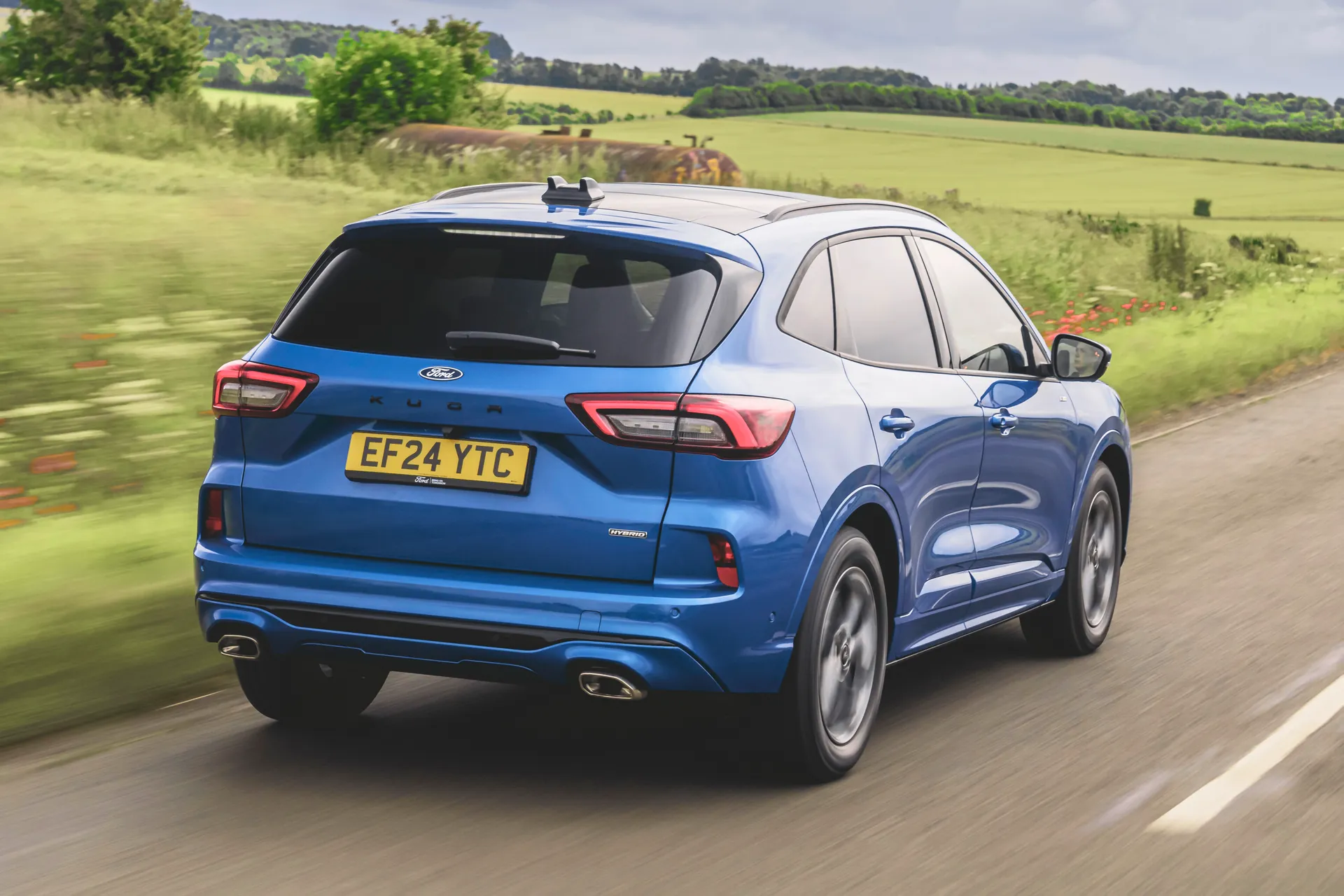
That said, the Kuga does retain that Ford handling DNA, which means it feels very responsive, fairly surefooted and mostly predictable, although there are times when the self-centring action of the steering can cause a few issues. But for an SUV this size, perhaps that’s all you can ask for. This is a car designed to carry things - not shave seconds off your lap times.
Overall ride quality is good (after an initial adjustment phase where you have to get used to its slightly firm edge). It feels supple around pot-hole-marked ring roads and smooth on the motorway. The Ford Kuga can get a little bouncy if you find yourself on an undulating road at speed, though.
The brakes on most models are smooth and progressive - but the Ford Kuga PHEV is more of a struggle to drive smoothly. The regenerative braking system means the pedal feels overly heavy, making you think that you’re braking harder than you are and leading to few tense moments when the final phase of braking doesn't produce the stopping force you expect it to.
What engines and gearboxes are available in the Ford Kuga?
Ford's cut down the range of Kuga engines since launch, leaving just three choices: petrol, full-hybrid and a plug-in hybrid.
The cheapest engine is a 1.5-litre petrol EcoBoost engine that's offered exclusively with a six-speed manual gearbox and front-wheel drive. This was available with 120PS in the entry-level Ford Kuga Zetec, but now you'll only find the 150PS version available across the range, and it's a better option with a useful extra dollop of power.
There's a full-hybrid version that's based around a 2.5-litre petrol Duratec engine with 190PS, but it's the plug-in hybrid option that'll probably spike the most interest. It combines a 2.5-litre petrol Duratec engine with an electric motor to produce a combined 225PS (later uprated to 243PS).
But with front-wheel-drive only and an unresponsive CVT automatic gearbox, it’s not as much fun as it should be. On the plus side, though, it delivers an electric-only range of around 40 miles, perfect for short journeys and commutes. However, just like any other plug-in hybrid, if you fail to charge it regularly you'll be penalised by having to lug a heavy battery pack around with you that reduces fuel economy massively.
Missing from that list are the diesel options, which have recently been dropped from the range. If you're looking to buy used and cover a lot of miles, though you've got a few diesel Ford Kuga options. There’s a 1.5-litre EcoBlue diesel with 120PS and offered with a six-speed manual or eight-speed automatic gearbox. And a 2.0-litre mild-hybrid diesel, which produces 150PS and comes with a manual gearbox and front-wheel drive.
The most potent diesel available on the Ford Kuga is the 190PS 2.0-litre, which was sold exclusively with an eight-speed automatic gearbox and all-wheel-drive. It’s likely to be the Kuga of choice for caravanners or anyone who wishes to venture off the beaten track.
Refinement and noise levels
Most drivers will be happy with the standard suspension set up of the Ford Kuga, but the ST-Line models get a lower ride height and firmer springs, making them feel a touch more sporty and/or fidgety.
Bear in mind, too, that this will increase the amount of road noise you experience. While the poshed-up Vignale gets an active noise cancelling system (which neutralises unwanted noise using the car's speakers), most drivers will take some time to get used to the tyre roar and suspension rattle.
Opt for the PHEV version of the Ford Kuga and you'll be running about in near-silence under electric power, while the transition to petrol power is pretty seamless once the battery has been depleted.
Safety equipment: How safe is the Ford Kuga?
Like a lot of its competitors, the Ford Kuga scored five stars out of five for safety when tested by Euro NCAP. Drilling down on the numbers a little more, it scored 92% for adult occupants, 86% for child occupants, 82% for pedestrian safety and 73% for safety assist.
The Ford Kuga comes with 10 airbags dotted around the cabin and a number of standard safety features. This includes lane-keeping assistance and automatic emergency braking, which will apply the stoppers automatically if the car senses an impending crash.
All Ford Kugas come with front and rear parking sensors while a reversing camera is now standard across the range, too. This is almost essential in this car as visibility is limited by the small rear window and thick A-pillars. On earlier Kuga models, you'll have to look for one with the optional Driver’s Assistance Pack. That will also get you adaptive cruise control and traffic-sign recognition.
MPG and fuel costs: What does a Ford Kuga cost to run?
"Although they've now been dropped from the range, the old EcoBlue diesel engines made a lot of sense for high-mileage drivers. Look for a secondhand one of these if you cover a lot of motorway miles - you should easily see more than 50.0mpg in the real world."
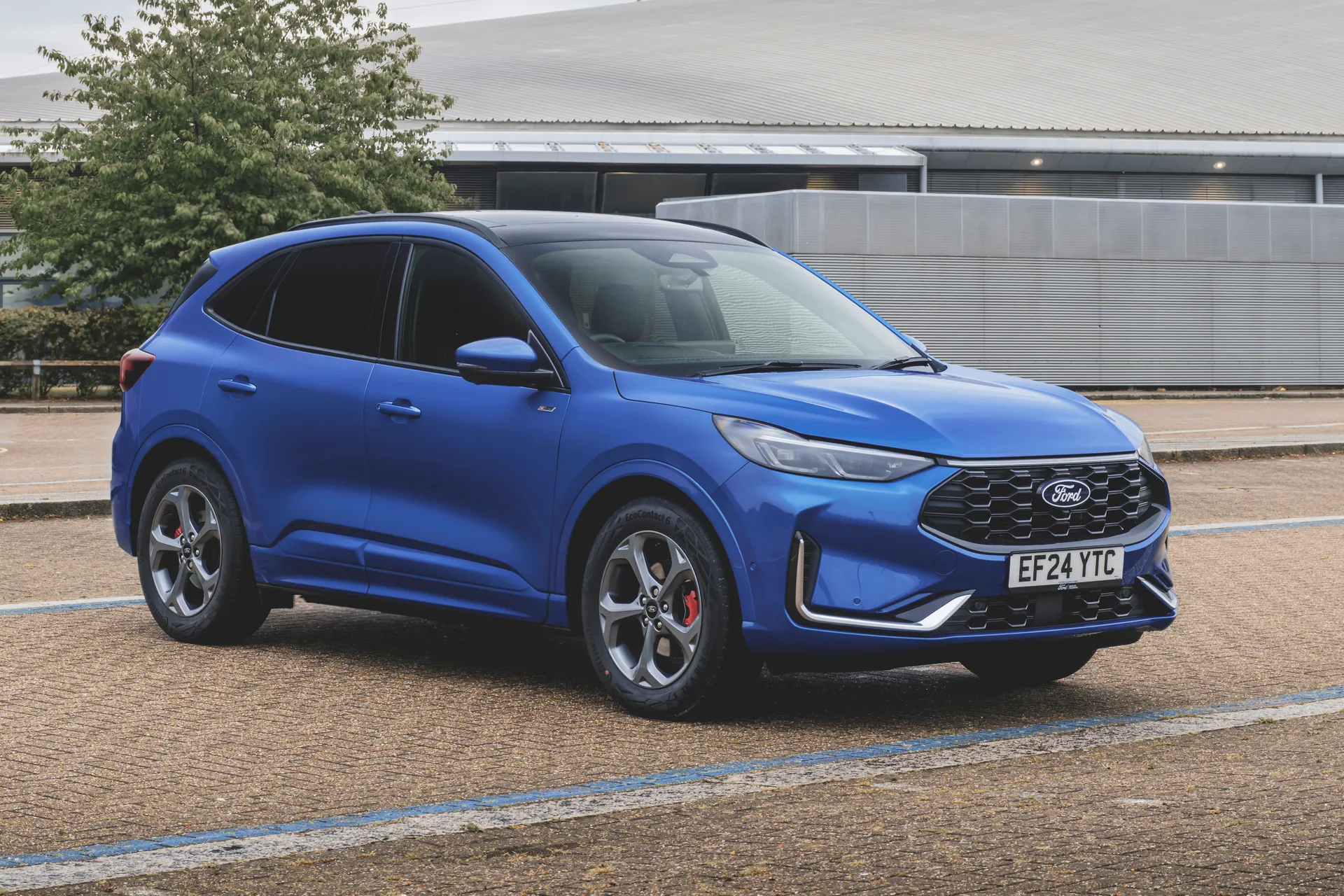
The 1.5-litre petrol Ford Kuga will be the thirstiest, with an official fuel economy figure of up to 42.2mpg. The hybrid improves on that slightly, returning up to 49.6mpg when paired with two-wheel drive, or 47.1mpg as a four-wheel-drive model. They're pretty easy-to-live with figures for minimal effort.
If you don't mind a bit more effort, though, the plug-in hybrids have the potential to be very efficient. Take the official claims of more than 300.0mpg with a pinch of salt - although their electric range of around 30 miles means you could cover a lot of shorter journeys without using any petrol.
How reliable is the Ford Kuga?
This generation of the Ford Kuga didn't get off to the strongest start when there was a large-scale recall of PHEV models due to an overheating fault that could cause a fire when charging. Fortunately, this was soon fixed, and the Kuga seems to be proving itself to be a pretty dependable SUV.
Ford doesn't perform especially strongly overall in reliability and owner satisfaction, coming in 23rd out of 30 manufacturers in the latest HonestJohn.co.uk Satisfaction Index.
Insurance groups and costs
Insurance groups range from 12 to 26, depending on which trim level and engine you choose. If you're looking for cheap car insurance, we'd recommend a Kuga with the 150PS 1.5-litre petrol engine. The plug-in hybrid is likely to be the most expensive to insure.
How much should you be paying for a used Ford Kuga?
"Prices for the new Ford Kuga start from around £32,000, while the more desirable hybrid models are closer to £40,000. It's not a budget option anymore, but neither are rivals like the Hyundai Tucson or Kia Sportage."
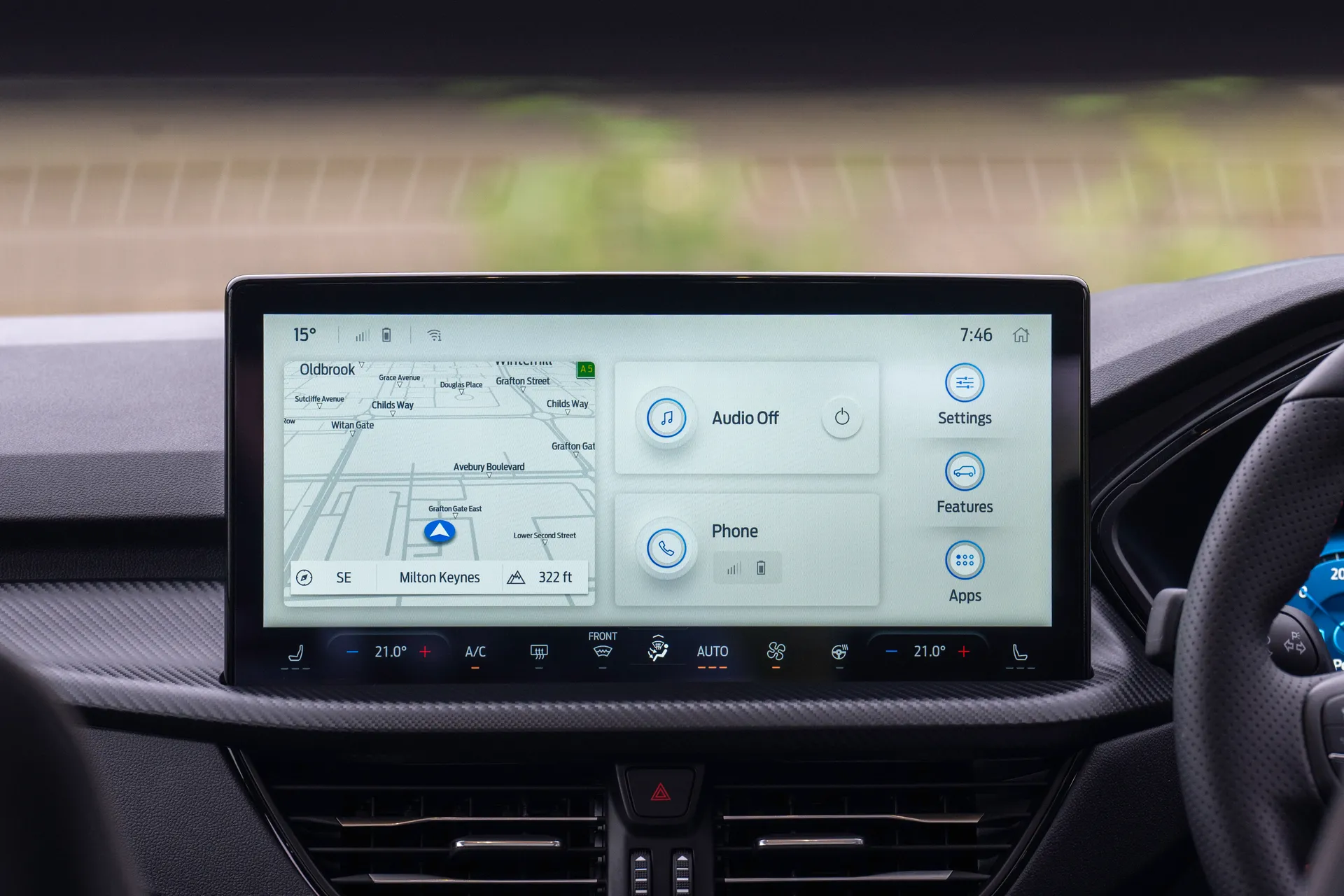
Fortunately, if you're not too concerned about buying the latest, facelifted Ford Kuga, you can save cash by seeking out a nearly-new model. A budget of around £16,000 will buy a 2020 Ford Kuga on heycar - that's half the price of a new one.
Looking for something a little newer? A 2023 Ford Kuga Titanium Edition with the 1.5-litre EcoBoost petrol engine can be picked up for £23,000. A one-year-old Ford Kuga plug-in hybrid will cost you around £26,000.
Trim levels and standard equipment
The Ford Kuga line-up currently consists of Titanium, Active, ST-Line and ST-Line X models.
The Ford Kuga Titanium kicks off the range, available with petrol power only. Standard kit includes 17-inch alloy wheels, LED lights, silver roof rails, power heated folding door mirrors, rear privacy glass and a manual tailgate. Inside, the Titanium comes with a 12.3-inch digital instrument cluster as well as a 13.0-inch SYNC 4 infotainment system with navigation, DAB radio, Apple CarPlay and Android Auto. Front and rear parking sensors are standard, as well as a rear-view camera and electronic climate control. The Titanium comes with cloth seat trim, an eight-way manually adjustable driver's seat and front passenger seat (including lumbar support and height adjustment) and sliding rear seats. Keyless entry/start are also standard, as well as cruise control, pre-collision assist and a Quickclear heated windscreen.
Offered with hybrid or plug-in hybrid power, the Ford Kuga Active builds on this with 18-inch alloy wheels, Active exterior body styling (including black mirror caps and a contrast black painted roof), black roof rails, a heads-free power tailgate and pop-out door edge protectors. The Kuga Active also comes with bespoke suspension providing a higher ground clearance while, inside, there's a B&O premium sound system, 360-degree camera and Sensico Active seats with power adjustment in the front. Pre-collision assist with autonomous emergency braking, evasive steer assist and dynamic brake support is standard, as well as adaptive cruise control, blind spot information, cross-traffic alert and a lane-keeping aid with lane-departure warning.
The sporty Ford Kuga ST-Line is available with petrol, hybrid or plug-in hybrid power. Specification highlights include 18-inch ST-Line alloy wheels, ST-Line exterior body styling, a large rear spoiler, red brake calipers, sports suspension, and partial Sensico sports seats with black neosuede inserts and red stitching.
Topping the range, the Ford Kuga ST-Line X comes with 19-inch alloy wheels, a panoramic glass sunroof, heated seats (front and rear) and a heated steering wheel.
Ask the heycar experts: common questions
Is the Ford Kuga a good car to buy?
Which Ford Kuga engine is best?
Is the Ford Kuga the best family SUV?
Ford Kuga Alternatives
Get our latest advice, news and offers
Keep me updated by email with the latest advice, news and offers from heycar.
By submitting you agree to our privacy policy
